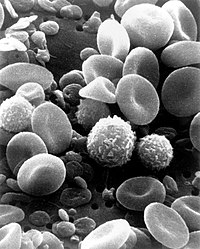
Photo from wikipedia
Objective To assess the peripheral immune system of newly diagnosed relapsing remitting multiple sclerosis (RRMS) patients and compare it to healthy controls (HC). Methods Cross-sectional study with 30 treatment-naïve newly… Click to show full abstract
Objective To assess the peripheral immune system of newly diagnosed relapsing remitting multiple sclerosis (RRMS) patients and compare it to healthy controls (HC). Methods Cross-sectional study with 30 treatment-naïve newly diagnosed RRMS patients, and 33 sex and age-matched HC. Their peripheral blood mononuclear cells were analysed regarding: i) thymic function surrogates [T cell receptor excision circles (TRECs) and recent thymic emigrants (RTEs)]; ii) naïve and memory CD4+ and CD8+ T cells subsets; iii) T helper (Th) phenotype and chemokine receptors expression on T cells subsets; iv) regulatory T cell (Tregs) phenotype; and vi) expression of activating/inhibitory receptors by natural killer (NK) and NKT cells. Analyses were controlled for age, sex, and human cytomegalovirus (HCMV) IgG seroprevalence. Results Newly diagnosed RRMS patients and HC have equivalent thymic function as determined by similar numbers of RTEs, and levels of sjTRECs, DJβTRECs and sj/DJβTREC ratio. In the CD8+ T cells compartment RRMS patients have a higher naïve/memory ratio and lower memory cell counts in blood, specifically of effector memory and TemRA CD8+ T cells. Among CD4+ T cells lower blood counts of effector memory cells are found in patients upon controlling for sex, age and HCMV IgG seroprevalence. RRMS patients have higher percentage of naive Tregs comparing to HC. Percentages of immature CD56bright NK cells expressing the inhibitory receptor KLRG1, and of mature CD56dimCD57+ NK cells expressing NKp30 are higher in patients. No major alterations are observed on NKT cells. MS severity and time from relapse correlate with immune cells alterations. Conclusion Characterization of the peripheral immune system of treatment-naïve newly diagnosed RRMS patients unveiled immune features present at clinical onset including lower memory T cells blood counts, particularly among CD8+ T cells, higher percentage of naïve Tregs and altered percentages of NK cells subsets expressing inhibitory or activating receptors. These findings might set the basis to better understand disease pathogenesis.
Journal Title: Frontiers in Immunology
Year Published: 2022
Link to full text (if available)
Share on Social Media: Sign Up to like & get
recommendations!